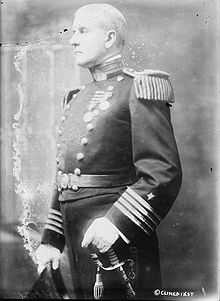William Fullam
| William Freeland Fullam | |
|---|---|
 | |
| Born |
October 20, 1855 Pittsford, New York |
| Died |
September 23, 1926 (aged 70) Washington, D.C. |
| Allegiance |
|
| Service/branch |
|
| Years of service | 1877–1919 |
| Rank | Rear Admiral |
| Commands held |
USS Chesapeake USS Mississippi |
| Battles/wars | World War I |
| Awards | Navy Cross |
Rear Admiral William Freeland Fullam (October 20, 1855 – September 23, 1926) was an officer in the United States Navy during World War I.
Biography
Born in Pittsford, New York, Fullam was a member of the United States Naval Academy class of 1877. His commands through his long and distinguished naval career ranged from the sailing ship USS Chesapeake in 1904 to the battleship USS Mississippi in 1909.
During World War I, Rear Admiral Fullam commanded the Reserve Force, Pacific Fleet, and Patrol Force, Pacific Fleet, and was senior officer in command of the Pacific Fleet during the absence of the Fleet's Commander-in-Chief in South Atlantic waters.
The merit of his service in such responsible positions was recognized with the award of the Navy Cross. Chief among his assignments ashore was Superintendent of the Naval Academy in 1914-1915.
In early 1918 Vice Admiral Kantarō Suzuki (who later became the 42nd Prime Minister of Japan from April 7, 1945 to August 17, 1945) brought his two cruisers Asama and Iwate to San Francisco and "banqueted" with Rear Admiral Fullam after receiving harbor entrance by Rear Admiral Fullam.
Rear Admiral Fullam retired on October 8, 1919, and died at Washington, D.C., aged 70.
Legacy
The destroyer USS Fullam (DD-474) was named for him.
To the Marine Corps, he was well-known to be an enemy to the Corps's institution and organization, due to his announcement that he would see that the Marine Corps is to be destroyed. The term Fullamite became a name that has long became registered in many military books denoted someone that refers to non-believers of the Marine Corps philosophy.
See also
| Wikimedia Commons has media related to William Fullam. |
References
- This article incorporates text from the public domain Dictionary of American Naval Fighting Ships. The entry can be found here.
| Academic offices | ||
|---|---|---|
| Preceded by John H. Gibbons |
Superintendent of United States Naval Academy 1914-1915 |
Succeeded by Edward Walter Eberle |
| ||||||
|